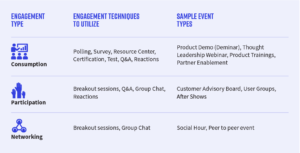We all say that we want to engage our audiences, give them compelling content and experiences that inspire and educate. But at the end of the day, not all engagement is created equal. And depending on the type of engagement you’re hoping to drive, you must use different techniques in order to achieve that level of engagement with the audience.
However marketers and events teams don’t have a common language or way of discussing this. Instead, people default to event format types to talk about engagement and that is missing the point. Teams focus on the container for the engagement rather than the engagement itself. Engagement must be created, an event does not equal engagement.We need to start with the engagement we’re looking to create in mind- with what the audiences requires- in order to set up events and experiences in a way that provides better experiences for audiences
Additionally, this will help marketers and events teams get out of the conundrum of getting pushed into a corner by focusing on the event type first. “We have to run a webinar or we have to run a roadshow- leads to subpar events that are more focused on setting a tactical goal of putting something on rather than something that is driving the experience on behalf of the audience.
The Center for Marketing Transformation defines these categories of engagement:
Consumption
This is when there is a hierarchy of presenter to audience. The audience is mainly present to be informed and take in the information that the presenter(s) are sharing.
Participation
This is where presenters and audience members are interacting directly without a hierarchy between both that is demanded by technology. Everyone is on
a level playing field as far as participation. A moderator may be anointed if there isn’t a presenter sharing content.
Networking
Without an assigned moderator or presenter,
all event participants are empowered to engage in conversation. The peer-to-peer nature of this engagement type allows for natural conversation flow without a strict agenda.
Each of these engagement types has different techniques that will need to be leveraged in order to ensure audience experience and participation is maximized. Failure to use the appropriate techniques can lead to a poor and disjointed audience experience and lack of insight from a marketing perspective.

By starting with the goal of the engagement you’re trying to drive with an experience, marketers and events teams will be able to better architect the experience itself. Aligning engagement goal with the appropriate techniques will also improve audience experience and engagement. Using this approach is critically important when you’re creating events that have multiple sessions, which could have carrying engagement goals. Each session should be aligned with an engagement type so that the sessions will be as impactful as possible and create the appropriate variety for audiences.
More Content For You
Digital Experiences Benchmark: Financial Services 2021 Report
This report will evaluate the performance of digital experiences in the financial services industry.
Digital Experiences Benchmark: Life Sciences 2021 Report
This report will evaluate the performance of digital experiences in the life sciences industry.